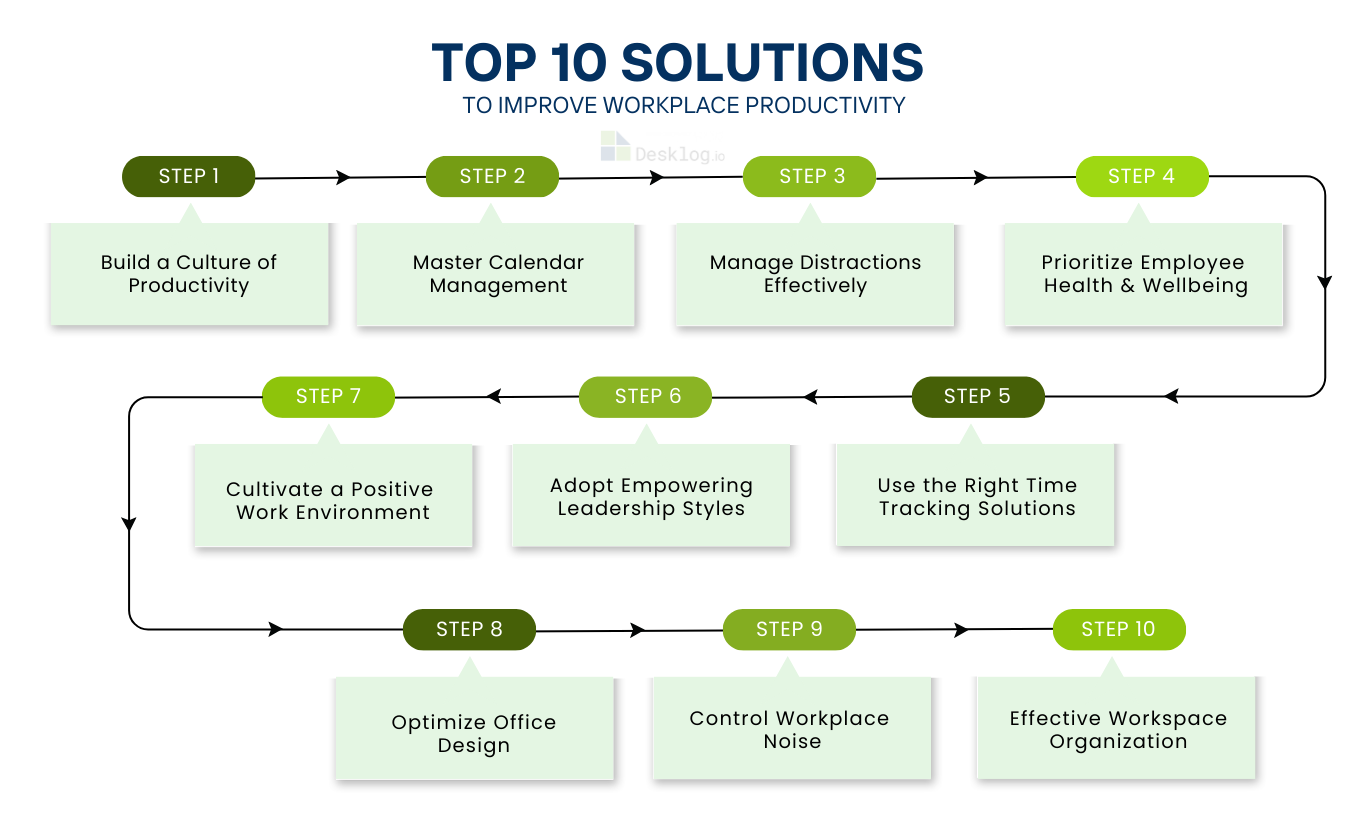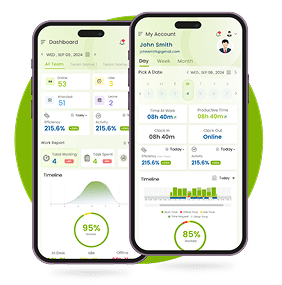Ever found yourself trying to work with a laptop balanced on a wobbly chair, seated beside a chatty colleague, under the glow of flickering lights? These everyday struggles highlight exactly what holds teams back from being productive. That’s why creating the right work environment with the right productivity tools is so important.

Research shows that 82% of employees believe well-being and engagement are the primary motivators of productivity- and as shown in the above video, a time tracking software like Desklog is one of the most efficient ways to eliminate workplace chaos.
In this blog, we’ll explore practical, proven ways to create a productive workplace. These Top 10 solutions can help make your work environment go from simply functional to highly effective. Let’s go!
What is Workplace Productivity?
Workplace productivity reflects the value each team contributes to the overall success of a business. It measures how efficiently employees use resources such as time, effort, and money to achieve goals and deliver results. Essentially, it’s about maximizing the impact of employees’ efforts within a given timeframe.
Why is Workplace Productivity Important?
Workplace productivity is important because it directly influences a company’s overall performance, profitability and ability to stay competitive. When employees work efficiently, using their time and resources wisely, businesses can achieve more with less- reducing costs, increasing output and improving quality.
Top 10 Solutions to Improve Workplace Productivity

Build a Culture of Productivity
Organizations that prioritize outcomes over hours and encourage autonomy tend to foster innovation and efficiency. By using employee time tracking softwares, you can measure productivity based on actual work completed rather than hours logged, promoting a culture focused on results. You can explore how your work hours are tracked and organized by trying our free demo.
How to do it:

Calculate employee efficient rates in multiple ways.

Recognize and reward high employee performance.

Encourage results-based performance reviews.
Master Calendar Management
Time-blocking, task batching and scheduling deep work are key to time mastery. Time tracking tools offer the option to create tasks and provide visual breakdowns of how time is spent, allowing employees to optimize scheduling. For example, features like Project Kanban View lets users track time per task while keeping a clear view of overall project progress.
How to do it:

Divide the work into different tasks for focused work.

Automate reminders for meetings and deliverables.

Batch similar tasks to reduce context-switching.
Manage Distractions Effectively
The silent killers of productivity? Workplace distractions. Knowing how and when they strike is the first step to defeating them. Activity tracking and idle time tracking tools can pinpoint exactly when productivity dips and why, helping teams fix the root cause.
How to do it:

Track app/URL use to pinpoint key distractions.

Block out specific times for distraction-free work.

Employ tech blockers and timed focus sessions.
Prioritize Employee Health & Wellbeing
Healthy employees bring focus, energy and resilience to the table. Investing in their well-being isn’t just good practice – it directly fuels productivity. Desklog offers reports to gain insights into workload distribution, break patterns and potential burnout risks. This data helps you to proactively support a balanced work life for your employees.
How to do it:

Set breaks and overtime notifications; offer flexible work schedules.

Provide options for flexible work arrangements for better balance.

Support well-being with mental health days and stress programs.
Use the Right Time Tracking Solutions
The right time tracking tools improve productivity and clarity- while the wrong ones create confusion and bottlenecks. Desklog is your all-in-one platform that supports time tracking, project tracking, activity tracking, attendance tracking and shift management– literally everything you would need to manage your employees, regardless of time zones and locations.
How to do it:

Evaluate your current time tracking setup for redundancies or gaps.

Opt for solutions that integrate with your project management tools.

Choose scalable platforms that adapt and grow with your team.
Adopt Empowering Leadership Styles
Micromanagement stifles initiative, while empowering leadership fosters accountability and a strong sense of ownership. Time tracking and project tracking features offer transparency into task progress without the need for constant check-ins, helping leaders stay informed without micromanaging.
How to do it:

Encourage open communication and autonomy.

Set clear goals and trust your team to deliver.

Offer coaching instead of constant oversight.
Cultivate a Positive Work Environment
A positive atmosphere is vital for a flourishing team. A strong, supportive culture fuels motivation and encourages employees to stay. By providing data on workload distribution, break adherence and project timelines, managers can proactively identify potential imbalances and prevent employee burnout.
How to do it:

Acknowledge small successes and celebrate achievements regularly.

Promote team unity through engaging bonding activities often.

Foster trust and psychological safety within the team environment.
Optimize Office Design
Workspaces profoundly impact mental clarity and workflow, making their design a key factor in productivity. Natural light improves focus and energy levels while ergonomic furniture supports physical well-being, reducing discomfort and distractions that hinder workflow.
How to do it:

Use layout zoning: create quiet zones, collaborative areas etc.

Incorporate standing desks, ergonomic chairs and natural light.

Add visual cues to support task flow and reduce friction.
Control Workplace Noise
Excessive noise disrupts concentration by increasing cognitive load. Conversely, complete silence can feel unnatural.The key is finding a consistent and predictable soundscape that allows the mind to focus on the task at hand.
How to do it:

Use sound-absorbing materials and white noise machines.

Designate quiet zones and collaboration spaces.

Encourage use of noise-cancelling headphones.
Effective Workspace Organization
Clutter overloads our senses and drains mental energy, forcing our brains to constantly process irrelevant visual information. In contrast, organized workspaces minimize these distractions, allowing for greater mental clarity and a smoother flow of thought.
How to do it:

Use digital systems to efficiently manage all work files.

Advocate for clean, minimalist desk setups for better focus.

Suggest quick, daily 5-minute decluttering habits.
Conclusion
Creating a productive work environment is not about quick fixes- it’s about building a foundation where employees feel supported to do their best work. From promoting a results based culture and using the right time tracking tools to prioritizing employee well-being and designing thoughtful workspaces, each strategy plays a vital role in improving overall productivity. Now’s the time to move beyond the basics and create a workspace where productivity and employee satisfaction go hand in hand.
FAQ
1Why is workplace productivity important?
It impacts business profitability, employee engagement, and competitiveness by ensuring efficient use of time and resources.
2 How can productivity be measured in the workplace?
Common metrics include output per hour, task completion rate, time tracking data, and key performance indicators (KPIs) aligned with business goals.
3What are the main factors that affect productivity?
Employee well-being, leadership style, workplace design, technology, distractions, and time management practices all influence productivity levels.
4How does time tracking improve productivity?
Time tracking helps identify inefficiencies, track workload distribution, and ensure employees focus on high-value tasks.
5What role does office design play in productivity?
A well-designed workspace with natural light, ergonomic furniture, and dedicated zones reduces distractions and improves focus and comfort.
6How do breaks influence productivity?
Regular breaks prevent burnout, improve mental clarity, and help employees maintain consistent performance throughout the day.

















